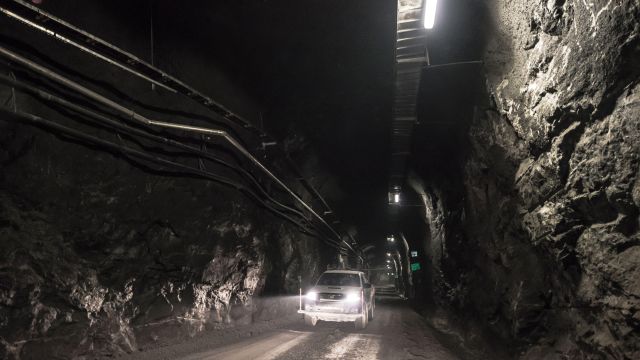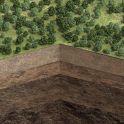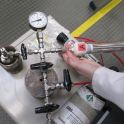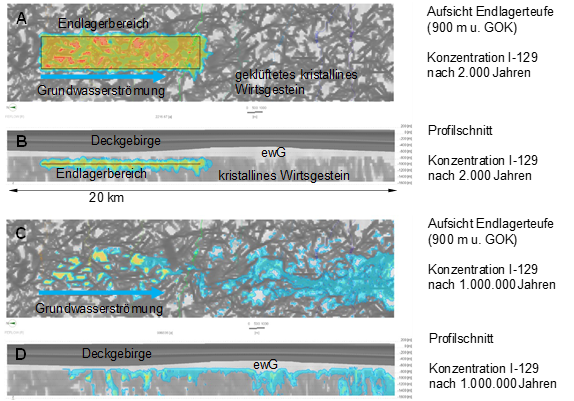
How and under what conditions can radionuclides disperse in a repository system in crystalline rock?
Researchers are currently unanimous that deep geological disposal is the best option for the safe management of high-level radioactive waste. In Germany, the search for a site for such a repository is still underway. Possible host rock formations in this country for such a repository are rock salt, argillaceous rock and crystalline rock. Each of the rock types has different characteristics, the advantages and disadvantages of which must be weighed against each other in the site selection process.
The special characteristic of crystalline rock is that, in contrast to clay and rock salt, it can also be fractured over a large area in the deep underground. Finding a coherent containment-providing rock zone (CRZ) for a possible repository in crystalline rock is therefore much more complicated than in clay or salt rock. Accordingly, the Site Selection Act provides for the basic alternatives of a superimposed CRZ or a multiple CRZ for crystalline rock. There is also the option of essentially ensuring the safe containment of the radioactive waste by means of the engineered and geotechnical barriers.
Fracturing in the focus of research
From its repository research centre in Braunschweig, GRS investigates issues relating to all three host rock types, with different focal points being relevant in each case. In the case of crystalline rock, for example, research focuses primarily on fracturing. Such fractures - figuratively speaking: cracks in the rock - can provide pathways for water to penetrate and reach the waste containers. The waste containers represent an important barrier in repository concepts for crystalline rock; however, should the containers corrode and e.g. radionuclides be released, the solutions that have entered can represent a transport path for radioactive and other substances released into the subsurface.
However, the fractures in the underground are very difficult to explore. One way to deal with this uncertainty is to use models to simulate possible transport processes. The Repository Research Centre uses 1D, 2D and 3D models for this purpose. In the recently completed CHRISTA-II research project funded by the Federal Ministry for Economic Affairs and Energy, GRS scientists developed models for various repository systems in crystalline rock (e.g. with an overlying CRZ) and analysed the dispersion of radionuclides in this system.
Model development for near field and far field
For one thing, models were created that consider the immediate vicinity of the waste containers and the CRZ (near field). Additionally, groundwater models were developed to model the groundwater flow for a large area around the repository system (far field). In the far-field calculations, the dispersion behaviour of the radionuclides caesium-135 and iodine-129 was investigated. Chemical elements differ in their properties, so that the radionuclide concentration in the model also differs depending on the element under consideration. One example is the retention of a substance on the rock surface of the fractures, so-called sorption. High sorption coefficients lead to slower dispersion with the groundwater. In the case of strongly sorbed radionuclides, this effect can become so great that their release from the CRZ is prevented. In the work, various parameters were varied to analyse the effects on dispersion behaviour.
Groundwater-bound contaminant transport simulated over a million years
Thus, the researchers simulated the groundwater-bound contaminant transport over a million years and calculated under which conditions the radionuclides could reach the biosphere.
The calculations showed that the overlying CRZ must have a very large expansion in order to reliably exclude a possible release of the radionuclides into the biosphere.
The follow-up project CHRISTA-III, which builds on the results from CHRISTA-I and -II and in which the Scandinavian KBS-3 system (repository container as essential barrier) is to be investigated, is already in the starting blocks. The procedure for this repository concept differs above all in that no CRZ has to be defined and accordingly its integrity does not have to be examined.
Project highlights Disposal
In a repository, geotechnical barriers contribute to the safe and long-term isolation of radioactive waste in the deep underground. The "sandwich" sealing system with its alternating sequence of sealing and filter segments is currently being tested as a geotechnical barrier in a large-scale experiment. GRS has assumed the technical leadership of the project at the international Mont Terri rock laboratory.

Germany is searching for a site for a repository for high-level radioactive waste. According to the Site Selection Act, the site with the best-possible safety is be found by means of a comparative procedure. But how can the requirements of the law be transformed into concrete scientific requirements? Together with other institutions, GRS researchers now present a first approach.

Claystone, salt rock or granite – it is in one of these three host rocks that a repository for high-level radioactive waste is to be constructed in Germany. This is where the waste is to be safely contained for one million years. In a current project carried out in GRS's geoscientific laboratory, research is being conducted into how the properties of claystone formations are changed by the waste emplaced.
